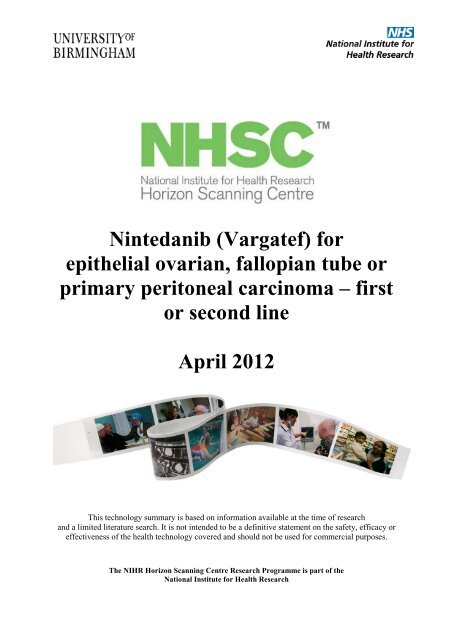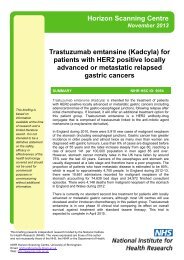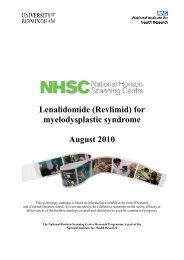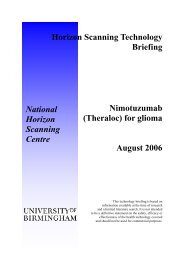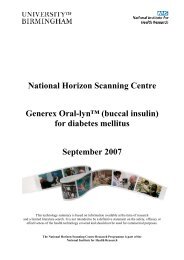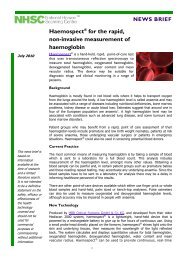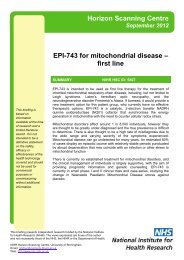Nintedanib (Vargatef) - National Horizon Scanning Centre - NIHR
Nintedanib (Vargatef) - National Horizon Scanning Centre - NIHR
Nintedanib (Vargatef) - National Horizon Scanning Centre - NIHR
Create successful ePaper yourself
Turn your PDF publications into a flip-book with our unique Google optimized e-Paper software.
<strong>Nintedanib</strong> (<strong>Vargatef</strong>) for<br />
epithelial ovarian, fallopian tube or<br />
primary peritoneal carcinoma – first<br />
or second line<br />
April 2012<br />
This technology summary is based on information available at the time of research<br />
and a limited literature search. It is not intended to be a definitive statement on the safety, efficacy or<br />
effectiveness of the health technology covered and should not be used for commercial purposes.<br />
The <strong>NIHR</strong> <strong>Horizon</strong> <strong>Scanning</strong> <strong>Centre</strong> Research Programme is part of the<br />
<strong>National</strong> Institute for Health Research
April 2012<br />
<strong>Nintedanib</strong> (<strong>Vargatef</strong>) for epithelial ovarian, fallopian tube or<br />
primary peritoneal carcinoma – first or second line<br />
Target group<br />
• Epithelial ovarian, fallopian tube or primary peritoneal carcinoma: advanced (stage<br />
IIB-IV) – first or second line; in combination with carboplatin and paclitaxel<br />
following initial surgery, where indicated.<br />
Background<br />
Primary ovarian, fallopian and peritoneal cancers arise from the epithelial tissues of the<br />
abdomen, fallopian tubes and ovaries. Almost 90% of adult ovarian tumours are epithelial<br />
cancers. Regardless of its origin, ovarian cancer leads to similar symptoms and is treated<br />
in a similar way 1<br />
. At the time of diagnosis, ovarian cancer has typically spread within the<br />
pelvis and abdomen (stage II-III cancer) or spread into the liver/beyond the abdominal<br />
cavity (stage IV cancer).<br />
Technology description<br />
<strong>Nintedanib</strong> (<strong>Vargatef</strong>; BIBF1120) is a potent, small molecule triple angiokinase inhibitor<br />
which suppresses tumour growth by preventing tumour angiogenesis. It inhibits three<br />
kinases involved in the development of tumour blood vasculature: platelet derived growth<br />
factor receptor alpha and beta (PDFR a/b), fibroblast growth factor receptor 1, 2 and 3<br />
(FGFR 1-3) and vascular endothelial derived growth factor receptor 1, 2 and 3 (VEGFR<br />
1-3). Inhibition of these receptors is thought to play a vital role in the prevention of<br />
tumour growth and spread. <strong>Nintedanib</strong> is administered orally at 200mg twice daily, in<br />
combination with carboplatin and paclitaxel.<br />
<strong>Nintedanib</strong> is in phase III clinical trials for idiopathic pulmonary fibrosis and non-small<br />
cell lung cancer, and in phase II trials for colorectal cancer, liver cancer, prostate cancer<br />
and renal cancer.<br />
Innovation and/or advantages<br />
If licensed, nintedanib in combination with carboplatin and paclitaxel may provide an<br />
additional treatment option for this patient group.<br />
Developer<br />
Boehringer-Ingelheim Pharmaceuticals.<br />
Availability, launch or marketing dates, and licensing plans<br />
In phase III clinical trials.<br />
NHS or Government priority area<br />
This topic is relevant to Improving Outcomes: A Strategy for Cancer (2011).<br />
Relevant guidance<br />
• NICE technology appraisal in development. Bevacizumab in combination with<br />
paclitaxel and carboplatin for the first-line chemotherapy treatment of ovarian cancer.<br />
Expected April 2013 2<br />
.<br />
• NICE technology appraisal. Trabectedin for the treatment of relapsed ovarian cancer.<br />
3<br />
2011 .<br />
2
April 2012<br />
• NICE technology appraisal. Paclitaxel, pegylated liposomal doxorubicin hydrochloride<br />
and topotecan for second-line or subsequent treatment of advanced ovarian cancer.<br />
2005 4<br />
.<br />
• NICE technology appraisal. Guidance on the use of paclitaxel in the treatment of<br />
5<br />
ovarian cancer. 2003 .<br />
• NICE clinical guideline. The recognition and initial management of ovarian cancer.<br />
6<br />
2011 .<br />
• European Society for Medical Oncology. Newly diagnosed and relapsed epithelial<br />
ovarian carcinoma: ESMO clinical practice guidelines for diagnosis, treatment and<br />
follow-up. 2010 7<br />
.<br />
8<br />
• SIGN. Epithelial ovarian cancer. 2003 .<br />
Clinical need and burden of disease<br />
Ovarian cancer is the fourth most common cancer in women in the UK 9 , with an agestandardised<br />
5-year survival rate of 38.2% 10 . Most women present with advanced<br />
disease 11 and although many patients respond to initial treatment, up to 70% of patients<br />
with advanced-stage ovarian cancer subsequently relapse 12 . The median time to<br />
progression after primary treatment (surgery plus chemotherapy) is 16-20 months, and the<br />
median overall survival is 31-51 months 13<br />
.<br />
Over 80% of cases are diagnosed in women over 50 years of age, with the highest<br />
incidence in women aged 65 and over 14 . In 2008, there were 6,156 new cases registered<br />
for ovarian cancer in England and Wales 14 , and 4,212 deaths occurred in 2010 15 . In<br />
England, there were 37,898 admissions for ovarian, fallopian tube and peritoneal cancer<br />
(ICD C56, C57 and C48 respectively) resulting in 86,674 bed days and 40,611 finished<br />
consultant episodes in 2010-11 16<br />
.<br />
Existing comparators and treatments<br />
Most women will undergo debulking surgery followed by six cycles of adjuvant<br />
chemotherapy 11 . First line chemotherapy is invariably platinum-based therapy alone, or<br />
in combination with paclitaxel (where the platinum agent is usually carboplatin but<br />
occasionally cisplatin). Bevacizumab in combination with carboplatin and paclitaxel is<br />
currently being appraised by NICE. Second line chemotherapy is non-curative and aims<br />
to reduce symptoms and prolong survival. Ovarian tumours eventually develop multidrug<br />
resistance. Current chemotherapy options for second and subsequent line disease<br />
include pegylated liposomal doxorubicin (Caelyx), trabectedin, topotecan, gemcitabine,<br />
paclitaxel 4,5,17,18<br />
.<br />
Efficacy and safety<br />
Trial NCT00710762, 1199.99; adults;<br />
nintedanib vs placebo; phase II.<br />
AGO-OVAR12/LUME-OVAR 1,<br />
NCT01015118, 1199.15, 2008-006831-<br />
10; adults; nintedanib with chemotherapy<br />
vs placebo with chemotherapy; phase III.<br />
Sponsor Boehringer-Ingelheim Pharmaceuticals. Boehringer-Ingelheim Pharmaceuticals.<br />
Status Published. Ongoing.<br />
Source of<br />
information<br />
Publication 19 , trial registry 20<br />
.<br />
21<br />
Trial registry .<br />
Location UK. EU (inc UK), USA, Canada, Australia,<br />
Ukraine and Russia.<br />
Design Randomised, controlled. Randomised, controlled.<br />
3
April 2012<br />
Participants<br />
and schedule<br />
n=84 (planned); ovarian, fallopian tube<br />
or primary peritoneal cancer; advanced;<br />
responded to second, third or fourth line<br />
chemotherapy.<br />
Randomised to: nintedanib, oral, 250mg<br />
twice daily continuously for nine 28 day<br />
cycles (36 weeks) or placebo, twice daily<br />
for nine 28 day cycles (36 weeks).<br />
<strong>Nintedanib</strong> dose reduced to 150mg, twice<br />
daily and subsequently to 100mg, twice<br />
daily in the event of unacceptable drug<br />
related toxicity. Patients alive and<br />
progression free after nine cycles allowed<br />
to continue unblinded treatment.<br />
n=1,300 (planned); epithelial ovarian,<br />
fallopian tube or primary peritoneal<br />
cancer; stages IIB-IV; prior surgery or<br />
biopsy.<br />
Randomised to: nintedanib, oral, 200mg<br />
twice daily with carboplatin, AUC 5-6<br />
and paclitaxel, IV, 175mg/m 2 , every 21<br />
days for six cycles, followed by<br />
nintedanib monotherapy for up to 120<br />
weeks, or placebo with carboplatin AUC<br />
5-6 and paclitaxel, IV, 175mg/m 2 , every<br />
21 days for six cycles followed by<br />
placebo monotherapy for up to 120<br />
weeks.<br />
Active treatment period up to 120 weeks;<br />
5 years follow-up.<br />
Follow-up Active treatment period 36 weeks, plus<br />
continuing treatment where appropriate.<br />
Primary<br />
outcome<br />
Progression free survival (PFS). PFS.<br />
Secondary Tumour progression; overall survival; Overall survival; time to tumour marker<br />
outcome treatment compliance; safety.<br />
progression; objective response; safety;<br />
health-related quality of life.<br />
Key results For nintedanib and placebo respectively<br />
(%): PFS at 36 weeks, 16.3 (95% CI 5.2<br />
– 27.3), 5.0 (95% CI 0.0 – 11.8); PFS<br />
hazard ratio (HR) 0.65 (95% CI 0.42-<br />
1.02); overall survival HR, 0.84 (95% CI<br />
0.51 – 1.39); median time on treatment<br />
(mths), 2.8, 2.8.<br />
-<br />
Adverse Grade 3 or 4 AEs for nintedanib and -<br />
effects (AEs) placebo respectively (%): abdominal pain<br />
9.3, 7.5; diarrhoea, 9.3, 2.5; nausea, 2.3,<br />
0; vomiting 4.6, 2.5; fatigue 4.6, 0;<br />
anorexia 2.3, 0; constipation 7.0, 10.0;<br />
hypertension, 4.6, 0; ascites, 7.0, 10.0;<br />
any grade 3 or 4 AE, 34.9, 27.5 (p=0.49).<br />
Expected<br />
reporting<br />
date<br />
- July 2016.<br />
Estimated cost and cost impact<br />
The cost of nintedanib is not yet known. The costs of other selected treatments for<br />
epithelial ovarian cancer are 22<br />
:<br />
Drug Dose 23<br />
a<br />
Cost per cycle<br />
Paclitaxel 80mg/m 2 IV, on days 1, 8 and 15 of a 28 day<br />
cycle.<br />
£902<br />
Liposomal<br />
doxorubicin (Caelyx)<br />
40mg/m 2 IV, every 28 days. £1,073<br />
Topotecan<br />
4mg/m<br />
(Hycamtin)<br />
2 IV, on days 1, 8 and 15 of a 28 day £1,744<br />
cycle.<br />
a Based on average surface area of 1.7m 2 . Assumes wastage.<br />
4
April 2012<br />
Claimed or potential impact – speculative<br />
Patients<br />
� Reduced mortality or increased<br />
length of survival<br />
� Reduction in associated morbidity<br />
or improved quality of life for<br />
patients and/or carers<br />
Other: None identified<br />
Services<br />
Increased use<br />
Costs<br />
Quicker, earlier or more accurate<br />
diagnosis or identification of<br />
disease<br />
Service organisation Staff requirements<br />
Decreased use Other: � None identified<br />
Increased unit cost compared to<br />
alternative<br />
� New costs: uncertain unit cost<br />
compared to alternatives<br />
Increased costs: more patients Increased costs: capital<br />
coming for treatment<br />
investment needed<br />
Savings: Other:<br />
Other issues<br />
Clinical uncertainty or other research question identified: � None identified<br />
References<br />
1 Cancer Research UK. http://www.cancerhelp.org.uk/type/ovarian-cancer/ Accessed 6 December 2011.<br />
2 <strong>National</strong> Institute for Health and Clinical Excellence. Bevacizumab in combination with paclitaxel and<br />
carboplatin for the first-line chemotherapy treatment of ovarian cancer. Technology appraisal in development.<br />
Expected date of issue April 2013.<br />
3 <strong>National</strong> Institute for Health and Clinical Excellence. Trabectedin for the treatment of relapsed ovarian cancer.<br />
Technology appraisal TA222. London: NICE; April 2011.<br />
4 <strong>National</strong> Institute for Health and Clinical Excellence. Paclitaxel, pegylated liposomal doxorubicin<br />
hydrochloride and topotecan for second-line or subsequent treatment of advanced ovarian cancer. Technology<br />
appraisal TA91. London: NICE; May 2005.<br />
5 <strong>National</strong> Institute for Health and Clinical Excellence. Guidance on the use of paclitaxel in the treatment of<br />
ovarian cancer. Technology appraisal TA55. London: NICE; January 2003.<br />
6 <strong>National</strong> Institute for Health and Clinical Excellence. The recognition and initial management of ovarian<br />
cancer. Clinical guideline CG122. London: NICE; April 2011.<br />
7 Colombo N, Peiretti M, Parma G et al. Newly diagnosed and relapsed epithelial ovarian carcinoma: ESMO<br />
clinical practice guidelines for diagnosis, treatment and follow-up. Annals of Oncology 2010;21(suppl 5):v23v30.<br />
8 Scottish Intercollegiate <strong>National</strong> Guidelines. Epithelial ovarian cancer. Clinical guideline 75. October 2003.<br />
9 Cancer Research UK. Ovarian cancer statistics – key facts.<br />
http://info.cancerresearchuk.org/cancerstats/types/ovary/uk-ovarian-cancer-statistics Accessed 3 November<br />
2011.<br />
10 Rachet B, Maringe C, Nur U et al. Population-based cancer survival trends in England and Wales up to 2007:<br />
an assessment of the NHS cancer plan for England. Lancet Oncology 2009;10(4):351-369.<br />
11 Morgan Jr RJ, Alvarez RD, Armstrong DK et al. Ovarian cancer. Clinical practice guidelines in oncology. The<br />
Journal of the <strong>National</strong> Comprehensive Cancer Network 2008;6:766-94.<br />
12 Herzog TJ and Pothuri B. Ovarian cancer: a focus on management of recurrent disease. Nature Clinical Practice<br />
Oncology 2006;3:604-11.<br />
13 Friedlander M, Hannock KC, Rischin D et al. A phase II, open-label study evaluating pazopanib in patients<br />
with recurrent ovarian cancer. Gynaecologic Oncology 2010;119:32-37.<br />
14 Cancer Research UK. Ovarian cancer – UK incidence statistics.<br />
http://info.cancerresearchuk.org/cancerstats/types/ovary/incidence/ Accessed 21 March 2012.<br />
15 Office for <strong>National</strong> Statistics. Mortality statistics: deaths registered in 2010 (Series DR) Table 5.<br />
www.ons.gov.uk<br />
16 NHS. Hospital episode statistics. NHS England 2010-11. HES data 2011. www.hesonline.nhs.uk<br />
5
April 2012<br />
17 CancerResearchUK. Chemotherapy for ovarian cancer. http://cancerhelp.cancerresearchuk.org/type/ovariancancer/treatment/chemotherapy-for-ovarian-cancer<br />
Accessed 17 April 2012.<br />
18 <strong>National</strong> <strong>Horizon</strong> <strong>Scanning</strong> <strong>Centre</strong>. Lapatinib (Tyverb) in combination with trastuzumab for HER2-positive<br />
metastatic breast cancer. http://www.nhsc-healthhorizons.org.uk/topics/lapatinib-tyverb-in-combination-withtrastuzumab-f/<br />
Accessed 21 March 2012.<br />
19 Ledermann JA, Hackshaw A, Kaye S et al. Randomized phase II placebo-controlled trial of maintenance<br />
therapy using the oral triple angiokinase inhibitor BIBF 1120 after chemotherapy for relapsed ovarian cancer.<br />
Journal of Clinical Oncology 2011;29(28):3798-3804.<br />
20 ClinicalTrials.gov. A randomised placebo-controlled phase II study of continuous maintenance treatment with<br />
BIBF 1120 following chemotherapy in patients with relapsed ovarian cancer.<br />
http://clinicaltrials.gov/ct2/show/NCT00710762?term=nct00710762&rank=1 Accessed 22 March 2012.<br />
21 ClinicalTrials.gov. LUME-Ovar 1: nintedanib (BIBF 1120) or placebo in combination with paclitaxel and<br />
carboplatin in first line treatment of ovarian cancer.<br />
http://clinicaltrials.gov/ct2/show/NCT01015118?term=nct01015118&rank=1 Accessed 22 March 2012.<br />
22 British Medical Association and Royal Pharmaceutical Soceity of Great Britain. British <strong>National</strong> formulary.<br />
BNF 62. London: BMJ Group and RPS Publishing, September 2011.<br />
23 <strong>National</strong> <strong>Horizon</strong> <strong>Scanning</strong> <strong>Centre</strong>. Paclitaxel (Paclical) for epithelial ovarian cancer, fallopian tube cancer or<br />
peritoneal cancer – second or third line. http://www.nhsc-healthhorizons.org.uk/topics/paclitaxel-paclical-forepithelial-ovarian-cancer/<br />
Accessed 21 March 2012.<br />
The <strong>National</strong> Institute for Health Research <strong>Horizon</strong> <strong>Scanning</strong> <strong>Centre</strong> Research Programme is<br />
funded by the Department of Health.<br />
The views expressed in this publication are not necessarily those of the NHS, the <strong>NIHR</strong> or the<br />
Department of Health<br />
The <strong>NIHR</strong> <strong>Horizon</strong> <strong>Scanning</strong> <strong>Centre</strong>,<br />
Department of Public Health and Epidemiology<br />
University of Birmingham, 90 Vincent Drive, Edgbaston, Birmingham, B15 2SP, England<br />
Tel: +44 (0)121 414 7831 Fax +44 (0)121 414 2269<br />
www.haps.bham.ac.uk/publichealth/horizon<br />
6


